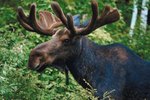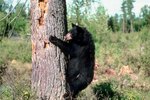
Grizzly bears are a subspecies of the brown bear; they're also called North American brown bears. As they hibernate for roughly half the year, they need to store a lot of fat to keep them nourished. The amount of body fat varies among bears, according to how much food they've managed to cram in, but the average bear can store up to 10 inches of fat all over his body.
About Grizzly Bears
Grizzly bears are large bears, generally brown in color but varying in shade from blond to black. They can weigh between 400 and 1,500 pounds at their peaks, males usually far larger than the females. They weigh less after hibernation, as they've used up most of their fat stores. They measure between 3 and 3 1/2 feet at the shoulder. In North America, they're found in Alaska, western Canada, Washing, Montana, Idaho and Wyoming, although their range used to be much larger, extending all the way down to California.
Diet
Grizzly bears need to constantly bulk up during all of their waking months to store enough body fat to get through hibernation. To gain weight, they eat up to 90 pounds of food every day and can gain more than 2 pounds in weight a day. They're omnivores, which means they eat both meat and plant foods. Despite their size and bulk, the majority of their diet is roots, berries and grasses. They eat insects and any animal carcasses they find, and they sometimes hunt small live prey other than insects. Grizzlies in parts of Alaska and Canada also eat large amounts of salmon, as these fish travel and gather in large numbers during their mating season.
Hibernation
Grizzly bears hibernate inside dens they dig themselves, normally in remote mountain areas, where the snow will act as insulation. They usually hibernate for between five and seven months, going into their dens in October and November and emerging between March and May. During this time they don't eat or drink at all, which is why having a thick layer of body fat is extremely important. Pregnant females give birth to cubs while they're hibernating, around January time, and raise them in dens until April or May. When they awaken, they will have lost almost all of their layer of body fat and around 15 percent to 30 percent of their total body weight.
Population and Status
According to the U.S. Fish and Wildlife Service, grizzly bears are a threatened species in the lower 48 states. Between the 1800s and 1975, their population in the lower 48 dropped from around 100,000 to less than 1,000. Today only 1,000 to 1,200 grizzly bears remain in this area. Main causes of their decline include loss of habitat and hunting. In Alaska they're still relatively common, with a population of around 30,000, and aren't considered threatened or endangered.
References
Photo Credits
-
NA/AbleStock.com/Getty Images




